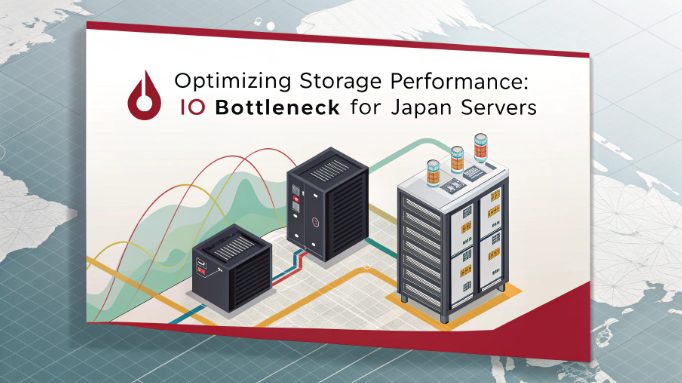Optimizing Storage Performance: IO Bottleneck for Japan Servers

Storage performance optimization remains a critical challenge for tech professionals managing servers in the rapidly evolving Japan hosting landscape. Whether you’re running high-traffic applications in Tokyo’s data centers or managing mission-critical databases in Osaka’s colocation facilities, understanding and resolving disk IO bottlenecks is paramount for maintaining optimal system performance.
Understanding Disk IO Bottlenecks in Japan Server Environments
The unique characteristics of Japan’s server infrastructure present specific challenges for storage performance optimization. With the country’s high-density data centers and stringent performance requirements, identifying and addressing IO bottlenecks becomes increasingly complex.
- Excessive random read/write operations impacting application response times
- Suboptimal cache configurations leading to increased disk activity
- Legacy RAID setups struggling with modern workload demands
- Hardware limitations in older hosting environments
Hardware-Level Optimization Strategies
Modern storage solutions offer various paths to enhanced performance, particularly in Japan’s technology-forward server environments.
- NVMe Implementation:
- Direct memory access reducing IO overhead
- Parallel operation capabilities for improved throughput
- Reduced latency in high-density computing environments
- RAID Configuration Enhancement:
- RAID 10 for optimal balance of performance and redundancy
- Strategic use of RAID 0 for temporary data storage
- Cache optimization for RAID controllers
System-Level Performance Tuning
Optimizing at the system level requires a methodical approach to configuration and parameter adjustment, particularly for servers operating within Japan’s infrastructure.
- IO Scheduler Configuration:
- Implementing deadline scheduler for database servers
- Using CFQ (Completely Fair Queuing) for shared hosting environments
- BFQ optimization for desktop-class workloads
For optimal performance in Japanese data centers, consider these kernel parameter adjustments:
# Optimize VM subsystem for heavy IO workloads vm.dirty_ratio = 10 vm.dirty_background_ratio = 5 vm.swappiness = 10 # Enhance network performance for storage operations net.core.rmem_max = 16777216 net.core.wmem_max = 16777216
Application-Layer Optimization Techniques
Application optimization plays a crucial role in managing IO performance, especially in high-throughput Japanese hosting environments.
- Database Optimization:
- Implementing proper indexing strategies
- Optimizing query patterns for reduced disk access
- Buffer pool size adjustment based on workload
- Log Management:
- Implementing log rotation with appropriate compression
- Utilizing separate disk volumes for log storage
- Adjusting logging levels based on operational requirements
Monitoring and Performance Analysis
Effective monitoring is essential for maintaining optimal storage performance in Japanese server environments. Implementation of comprehensive monitoring solutions should include:
- Real-time Performance Metrics:
- IOPS (Input/Output Operations Per Second)
- Throughput rates in MB/s
- Average queue depth
- Response time measurements
- Monitoring Tools Integration:
- iotop for per-process IO monitoring
- iostat for system-wide IO statistics
- dstat for comprehensive system metrics
Japan-Specific Optimization Considerations
When optimizing storage performance in Japanese server environments, several local factors require special attention:
- Data Center Selection:
- Proximity to major internet exchanges in Tokyo and Osaka
- Power infrastructure reliability post-2011 regulations
- Natural disaster resilience measures
- Hardware Procurement:
- Local vendor support availability
- Compatibility with Japanese power standards
- Warranty and maintenance considerations
Case Studies and Best Practices
Recent implementations in Japanese hosting environments have demonstrated significant performance improvements:
- E-commerce Platform Optimization:
- 70% reduction in IO wait times
- 2.5x improvement in transaction processing speed
- Reduced storage overhead by 40%
- Gaming Server Enhancement:
- 95% decrease in random read latency
- Sustained performance during peak gaming hours
- Improved user experience metrics
Conclusion and Implementation Roadmap
Optimizing storage performance for servers in Japan requires a comprehensive approach combining hardware upgrades, system-level tuning, and application optimization. Success in the Japanese hosting market demands attention to local infrastructure requirements while maintaining global performance standards. For optimal results, implement these solutions systematically, with regular monitoring and adjustment based on performance metrics.
- Key Implementation Steps:
- Conduct thorough performance baseline assessment
- Implement hardware upgrades strategically
- Fine-tune system parameters progressively
- Maintain regular performance monitoring
By following these optimization strategies and considering Japan’s unique hosting environment, organizations can significantly improve their server storage performance and maintain competitive advantage in the Asian market. Remember that storage optimization is an ongoing process that requires regular assessment and adjustment to meet evolving performance demands.

